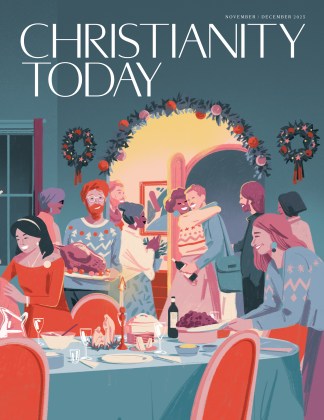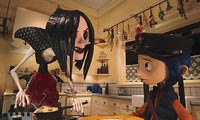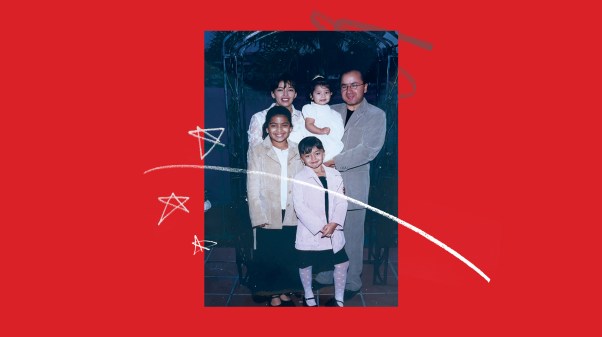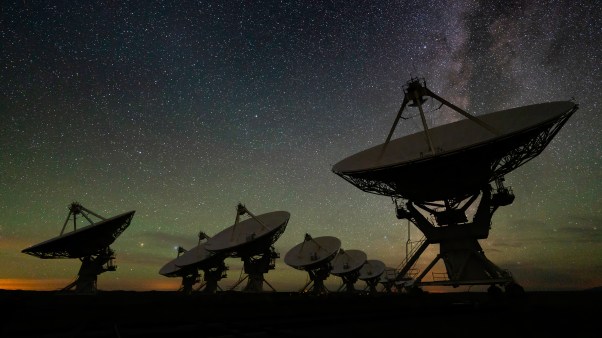Coraline, a horror film made for children, has some pretty heady stuff for adults too. When the best-selling book debuted in 2002, The New York Times dubbed it “one of the most truly frightening books ever written.”
Director Henry Selick, who also helmed The Nightmare Before Christmas and James and the Giant Peach, wasn’t afraid to transport the very things that made author Neil Gaiman’s novella so intoxicatingly unique—a curious mix of dank morbidity and gossamer whimsy—into his big-screen adaptation via brilliant stop-motion 3-D animation.
Gaiman and Selick’s work has more in common with Lewis Carroll and Maurice Sendak than with E.B. White or Beatrix Potter. Their world is like a parallel universe in which everything is familiar even as it is perverted by an eerie and, admittedly delicious, sense of the macabre. There is no denying that Coraline transports the viewer utterly and completely to another world, one full of petrifying monsters, incandescent beauty and inestimable bravery.
Coraline (voiced by Dakota Fanning) is a precocious young girl who fancies herself an explorer. It’s a good thing, too. She and her parents (Terry Hatcher and John Hodgman) have just moved into a new flat in an old house, and days of ceaseless Oregon rain has kept her pent up inside. Bored and feeling neglected by her busy parents, Coraline decides to explore her surroundings. Tucked into a corner of her living room, she discovers a small door plastered over with wallpaper. On the other side of the door is a long, luminescent tunnel, a heaving iridescent birth canal stretching out toward the horizon. While most kids would turn right back around, Coraline’s curiosity gets the better of her.

At the other end of the tunnel is a room almost identical to the one she just left, only different. It is cleaner, warmer and better furnished. In fact, on the other side of the tunnel lies a perfect mirror image of her family’s entire apartment. There she meets her “Other Mother” and “Other Father,” who look just like her real parents—except that they have shiny black buttons where their eyes are supposed to be. Coraline is understandably disturbed by this at first, but it isn’t long until she is completely overwhelmed by the hospitality shown her.
Coraline’s “other” parents lavish her with attention, fill her belly with splendid food (her real mother never cooks), and let her play to her heart’s content. Coraline is always the center of attention. Her every whim is catered to. These “other” parents invite her to stay in this idyllic world with them forever. There’s just one catch: She’ll need to replace her eyes with buttons.
Frightened, Coraline flees, only to discover her real parents have been kidnapped by her “Other Mother,” who demands Coraline return to her forever. The young girl realizes that her only hope of saving her parents is to confront the “Other Mother,” who has now taken on her true, monstrous shape. Mustering all her resourcefulness and courage, Coraline decides to risk both body and soul to save those she loves.

Gaiman—who recently won the 2009 Newbery Medal, the Pulitzer of children’s literature—has become the storytelling virtuoso of our age. An author, graphic novelist, screenwriter and poet, Gaiman’s deliciously skewed mind has fired the imaginations and sent shivers down the spines of many a child. His are not the bogus scares of juvenile literature, but an authentic, Poe-esque foreboding. Director Selick has imported that sensation bit by mouth-watering bit. Every noun and every verb of Gaiman’s book finds itself transformed into the medium of cinema, reborn as projected particles of light in an appropriately dark theater.
Coraline looks as good as it sounds. Selick has taken advantage of evolutionary leaps forward in 3-D technology and applied them to his traditional stop-motion animation. The result is the first ever high-definition stereoscopic 3-D movie. Everything in the film was handmade—every character, every structure, every expression, every tree and every leaf—and then painstakingly aligned frame by frame. To watch Coraline in 3-D is to be absorbed in a tactile world as shockingly superior to what preceded it as when a black-and-white Dorothy climbed off her demolished front porch and first looked upon the radiant color of Oz. This is a rich, intricate world of microscopic detail, nothing short of complete, immersive enchantment.
None of Selick’s magic would matter if he weren’t already working with a stupendous story. Gaiman understands the child’s psyche. He is in tune with children’s desires and fears like few other artists. When Coraline grows frustrated by a cadre of grown-ups who don’t take her seriously because of her young age, Gaiman taps into an aggravation all kids share. When he creates an alternate universe in which parents cater to a child’s every whim and desire, eschewing discipline and punishment, he zeroes in on an anarchical fantasy all kids hold. When he fashions a counterfeit mother who lives to give Coraline the personal attention she needs, he deeply intuits what all neglected and attention-starved children dream of. And when everything comes tumbling down and the only hope for survival in an oppressively dark and deadly state of affairs is the courage and resourcefulness of a child, Gaiman shows he still hears the beat of the child’s heart—to be a valiant hero, vanquishing malevolent dragons wherever they appear.
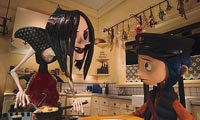
Often, movies about child “empowerment” are little more than excuses to make parents and authority figures look dumb—ignorant, out-of-touch dolts who come to look like fools at the hands of their smarter, wiser children. This is not the case with Coraline. Gaiman and Selick’s prepubescent hero never dishonors her parents. She does not want them less involved in her life—exactly the opposite. Her heart’s cry is that they take an even greater interest in her. While she is hurt that they are too busy to show her the attention she needs (and deserves), at no time does she react by dishonoring them. True, she finds great delight, at first, in the responsibility-free world the “Other Mother” creates for her, but she comes to see that world for what it is—a counterfeit sham that endangers far more than it liberates. Having parents who let you do anything you want may be the dream of every child, but such authority figures frequently turn out to be the true monsters. Real parents set guidelines out of love.
How well do you remember your fairy tales? Chances are that most of us retain the versions passed down to us by Walt Disney, sanitized and sterile stories nearly bereft of any real, deeper meaning. Do you remember the part in Cinderella where the wicked stepsisters cut off their toes in a vain attempt to make the blood-soiled glass slipper fit their feet? It comes right before birds peck out their eyes. Or Hansel and Gretel, in which a witch meets her death in a roaring oven at the hands of two children she was trying to cannibalize? Or Little Red Riding Hood, in which an old woman and a little girl are rescued only after a woodsman guts the wolf that ate them and pulls the gore-soaked victims from its stomach? Or The Little Mermaid, who commits suicide when she loses her lover?
These are how the fairy tales originally read. The Brothers Grimm frequently lived up to their name.

Coraline acknowledges that real life can be creepy, spooky and full of darkness. The filmmakers contend that there is nothing wrong with a children’s story that is willing to show the world for how it really is. In Coraline’s universe, as in our own, devils prowl about, tempting the unaware to certain doom.
Parents will question Coraline‘s appropriateness for young children. Depending on the child’s maturity level—and ability to distinguish fiction from reality—scary fairy tales can allow children to work through their fears and come out on the other side braver, wiser and more resilient, having learned valuable lessons about right and wrong. Younger and less mature children may not fare quite so well after visiting such a dark-yet-beautiful modern fairy tale. It is a decision only a parent can make.
Perhaps the thing that ultimately gives the film permission to stray into the darker corners of the imagination is Coraline’s ultimate victory. She overcomes her monsters. The lessons she learns make her a better person. She comes to realize that we must be very careful what we wish for. What’s attractive on the outside may, in fact, hide a demonic center, the proverbial wolf in sheep’s clothing. Too often, what we wish for is not what we truly need or want. Too often what we wish for does more harm than good. It is a lesson Coraline comes to learn well. Our parents love us and have our best interests at heart, even when they cannot or do not always manage to show it.
Talk About It
Discussion starters- Is Coraline just asking for trouble? Is there such a thing as being too adventurous for one’s own good?
- How does the “Other Mother” prey on Coraline’s vulnerabilities? In what way does she capitalize on those things that Coraline most desires, namely the love and attention of her distracted parents? Why is it important to be aware of our weaknesses?
- What does the phrase “Be careful what you wish for” mean to you? Can you think of some times you got what you wished for and it turned out that you now wish you hadn’t?
- In what ways does the “Other Mother’s” seduction of Coraline remind you of similar tactics used by Satan to trip up believers?
- Do you feel Coraline learns her lessons by the end? Why or why not? In what ways are difficult trials good for us? What does Scripture say about trials? (See Romans 5:1-5; James 1:2-4.)
The Family Corner
For parents to considerCoraline is rated PG for thematic elements, scary images, some language and suggestive humor. The language is very moderate, but no less present. It is an edgy PG, vaulting past a G rating because of its scary elements, and the film is certainly not for every child. For those who think their children are mature enough to handle the film, they may find Coraline a significant addition to children’s lore, even with its dreadful images and dark surprises—which are countered by stunning beauty and rousing virtue. Coraline is a creative and absorbing parable for children merely masquerading as a nightmare. Some parents will object to some of the more risqué elements (a particularly buxom character does little to hide her endowment). This is not a film for especially young children. It’s not that older kids won’t be scared, but they should be able to separate the fantasy from the reality more readily.
Photos © Copyright Focus Features
Copyright © 2009 Christianity Today. Click for reprint information.
